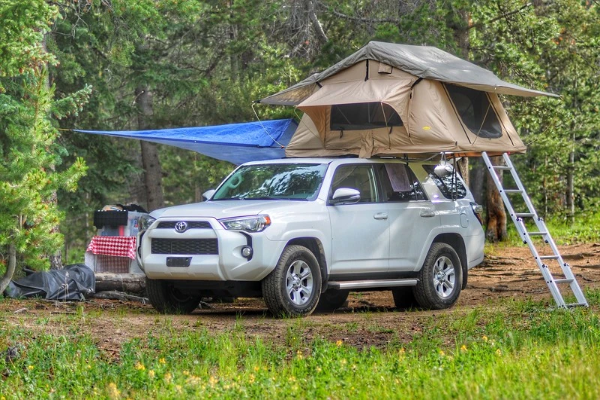A rooftop tent is a type of tent designed to be set up on the roof of a vehicle. It provides a comfortable and elevated camping experience. Rooftop tents are popular among campers, overlanders, and adventurers. They offer convenience and safety. Let’s explore what a rooftop tent is, its benefits, types, setup, and maintenance.
See Also: Can I Carry a Gun While Hiking in California?
What Is a Rooftop Tent?
A rooftop tent is a tent mounted on the roof of a car, SUV, or truck. It unfolds from a compact, stored position into a spacious sleeping area. The tent is usually made of durable materials. It has a sturdy base, often constructed from aluminum or hard plastic. This base provides a solid platform for sleeping.
Benefits of a Rooftop Tent
1. Elevated Sleeping Position
One of the main benefits of a rooftop tent is the elevated sleeping position. Being off the ground has several advantages. It keeps you away from insects and animals. It also provides better airflow, reducing condensation inside the tent.
2. Ease of Setup
Rooftop tents are easy to set up. Most models can be deployed in a matter of minutes. This convenience is especially useful after a long day of driving or hiking. You simply park your vehicle, unfold the tent, and you’re ready to sleep.
3. Comfort
Rooftop tents come with a built-in mattress. This feature adds to the comfort of your camping experience. The mattress is usually thicker and more comfortable than traditional camping pads. This ensures a good night’s sleep.
4. Versatility
Rooftop tents can be used in various environments. Whether you’re camping in the mountains, forest, or desert, a rooftop tent provides a reliable shelter. It can handle different weather conditions. Some models are even designed for extreme weather.
5. Space Saving
Since the tent is on the roof, it frees up space inside your vehicle. This allows you to carry more gear and supplies. It also makes packing and organizing easier.
Types of Rooftop Tents
1. Soft Shell Rooftop Tents
Soft shell rooftop tents are made of fabric. They are lighter and more affordable. These tents usually have a fold-out design. When packed, they are compact and low-profile. This reduces wind resistance and saves fuel.
2. Hard Shell Rooftop Tents
Hard shell rooftop tents have a rigid outer shell. They are more durable and offer better protection against the elements. These tents are often more aerodynamic. They also provide better insulation and noise reduction.
3. Pop-Up Rooftop Tents
Pop-up rooftop tents are a type of hard shell tent. They have a mechanism that allows the tent to pop up quickly. This type of tent is very easy to set up. It also provides a sleek, low-profile look when closed.
4. Fold-Out Rooftop Tents
Fold-out rooftop tents are similar to soft shell tents. They unfold to create a larger sleeping area. These tents often have an annex or additional room. This provides extra space for storage or changing clothes.
How to Set Up a Rooftop Tent
Setting up a rooftop tent is straightforward. Here are the general steps:
Park Your Vehicle: Find a level spot to park your vehicle. Ensure there are no overhead obstacles.
Unlock the Tent: Release the latches or locks that secure the tent in its closed position.
Unfold or Pop Up the Tent: Depending on the type of tent, either unfold or pop up the tent. Follow the manufacturer’s instructions.
Secure the Ladder: Most rooftop tents come with a ladder. Attach the ladder to the tent base. Ensure it is secure and stable.
Adjust the Windows and Doors: Open the windows and doors for ventilation. Attach any rainfly or additional covers if necessary.
Set Up the Mattress and Bedding: Arrange the mattress and bedding inside the tent. Ensure everything is comfortable and in place.
Maintenance and Care
Proper maintenance is essential for the longevity of your rooftop tent. Here are some tips:
Clean Regularly: Clean the tent fabric and base regularly. Remove any dirt, debris, or moisture. This prevents mold and mildew.
Inspect for Damage: Check for any signs of wear or damage. Repair any tears or broken parts promptly.
Store Properly: When not in use, store the tent in a dry, cool place. Ensure it is fully dry before storing to prevent mold.
Lubricate Moving Parts: Lubricate any moving parts, such as hinges and locks. This ensures smooth operation.
Follow Manufacturer’s Instructions: Always follow the manufacturer’s care and maintenance instructions. This ensures the tent remains in good condition.
Conclusion
In conclusion, rooftop tents are a convenient and comfortable way to camp. They provide easy access to established campsites and offer a raised sleeping platform above the ground. With quick setup and takedown times, rooftop tents allow campers to spend more time enjoying their surroundings. Additionally, since the tent is attached to the vehicle, it can be easily transported from one location to another without the need for additional equipment or vehicles. Overall, a rooftop tent is an excellent choice for those looking for a hassle-free camping experience.


